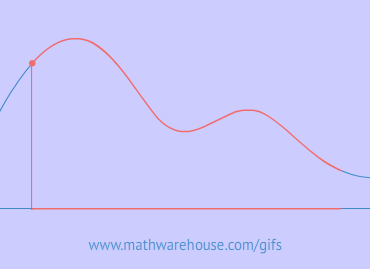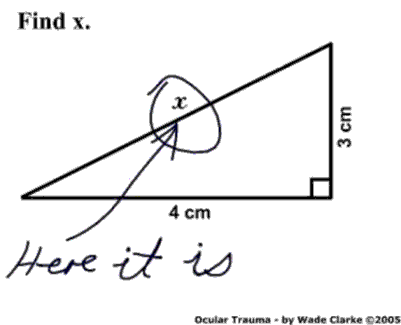Quick Summary
- The limit laws are simple formulas that help us evaluate limits precisely.
- There is a concise list of the Limit Laws at the bottom of the page.
The Limit Laws
For the following equations, $$a$$ and $$k$$ are constants and $$n$$ is an integer. Also, assume $$\displaystyle\lim\limits_{x\to a} f(x)$$ and $$\displaystyle\lim\limits_{x\to a} g(x)$$ both exist.
(1) Constant Law: $$\displaystyle\lim\limits_{x\to a} k = k$$This law deals with constant functions (horizontal lines). Since $$y$$ is always equal to $$k$$, it doesn't matter what $$x$$ approaches.
Example 1
$$\displaystyle\lim\limits_{x\to6} 8 = 8$$


This law deals with the function $$y=x$$. Since $$y$$ and $$x$$ are equal, whatever value $$x$$ approaches, $$y$$ will have to approach the same value.
Example 2
$$\displaystyle\lim\limits_{x\to 4} x = 4$$


This simply means, when we take the limit of an addition, we can just take the limit of each term individually, then add the results.
Example 3
$$\displaystyle\lim\limits_{x\to -7} (x + 5)$$
Solution:$$ \begin{align*} \displaystyle\lim_{x\to -7} (\blue{x} + \red{5}) & = \blue{\lim_{x\to -7} x} + \red{\lim_{x\to-7} 5} && \mbox{Addition Law}\\ & = \blue{-7} + \red{5} && \blue{Identity\hspace{2mm}Law}\hspace{2mm}and\hspace{2mm}\red{Constant\hspace{2mm}Law}\\ & = -2 \end{align*} $$
Essentially the same as the Addition Law, but for subtraction. Work with each term separately, then subtract the results.
Example 4
$$\displaystyle\lim\limits_{x\to\frac 1 2} (x-9)=$$
Solution:$$ \\ \begin{align*} \lim_{x\to\frac 1 2}(\blue{x}-\red{9}) & = \blue{\lim_{x\to\frac 1 2}x} - \red{\lim_{x\to\frac 1 2} 9} && \mbox{Subtraction Law}\\ % & = \blue{\frac 1 2} - \red{9} && \blue{Identity}\hspace{2mm}and\hspace{2mm}\red{Constant}\hspace{2mm}Laws\\ % & = \frac 1 2 - \frac{18} 2\\[6pt] % & = -\frac{17} 2 \end{align*} \\ $$
If your function has a coefficient, you can take the limit of the function first, and then multiply by the coefficient.
Example 5
$$\displaystyle\lim\limits_{x\to 3} (8x)$$
Solution:$$ \begin{align*} \lim_{x\to 3} (8x) & = 8\,\lim_{x\to 3} x && \mbox{Constant Coefficient Law}\\ & = 8 (3) && \mbox{Identity Law}\\ & = 24 \end{align*} $$
With the first 5 Limit Laws, we can now find limits of any linear function that has the form $$y = mx+b$$.
Example 6
$$\displaystyle\lim\limits_{x\to -2} (4x - 3)$$
Solution:$$ \begin{align*} \displaystyle\lim_{x\to -2} (4\blue{x} - \red{3}) & \displaystyle\lim_{x\to-2} (4\blue{x}) - \lim_{x\to-2} \red{3} && \mbox{Subtraction Law}\\ & = 4\,\blue{\lim_{x\to-2} x} - \red{\displaystyle\lim_{x\to-2} 3}&& \mbox{Constant Coefficient Law}\\ & = 4 (\blue{-2}) - \red{3}&& \blue{Identity}\hspace{2mm}and\hspace{2mm}\red{Constant}\hspace{2mm}Laws\\ & = -8 - 3\\ & =-11 \end{align*} $$
If the function involves the product of two (or more) factors, we can just take the limit of each factor, then multiply the results together.
Example 7
$$\displaystyle\lim\limits_{x\to 5} x^2$$
Solution:$$ \begin{align*} \displaystyle\lim_{x\to 5} x^2 & = \displaystyle\lim_{x\to 5} (\blue{x}\cdot \red{x})\\ & = \left(\blue{\lim_{x\to 5} x}\right)\left(\red{\lim_{x\to5} x}\right)&& \mbox{Multiplication Law}\\ & = (\blue{5})(\red{5}) && \mbox{Identity Law}\\ & = 25 \end{align*} $$
The first 6 Limit Laws allow us to find limits of any polynomial function, though Limit Law 7 makes it a little more efficient.
(7) Power Law: $$\displaystyle\lim\limits_{x\to a} \left(f(x)\right)^n= \left(\displaystyle\lim\limits_{x\to a} f(x)\right)^n$$ provided $$\displaystyle\lim\limits_{x\to a} f(x)\neq 0$$ if $$n <0$$When taking limits with exponents, you can take the limit of the function first, and then apply the exponent. But you have to be careful! If the exponent is negative, then the limit of the function can't be zero!
Example 8
$$\displaystyle\lim\limits_{x\to4} (x + 1)^3$$
Solution:$$ \begin{align*} \displaystyle\lim_{x\to4} (\blue{x}+\red{1})^3 & = \left(\displaystyle\lim_{x\to4} (\blue{x}+\red 1)\right)^3 && \mbox{Power Law}\\ & = \left(\blue{\displaystyle\lim_{x\to4} x} + \red{\displaystyle\lim_{x\to4} 1}\right)^3 && \mbox{Addition Law}\\ & = (\blue 4 + \red 1)^3 && \blue{Identity}\hspace{2mm}and\hspace{2mm}\red{Constant}\hspace{2mm}Laws\\ & = 5^3\\ & = 125 \end{align*} $$
Example 9
$$\displaystyle\lim\limits_{x\to -2} (4x^3 + 5x)$$
Solution:$$ \begin{align*} \displaystyle\lim_{x\to-2} (4\blue{x}^3 + 5\red{x}) & = \lim_{x\to-2} (4\blue{x}^3) + \displaystyle\lim_{x\to-2} (5\red x) && \mbox{Addition Law}\\ & = 4\,\displaystyle\lim_{x\to-2} (\blue{x}^3) + 5\,\displaystyle\lim_{x\to-2} \red x && \mbox{Constant Coefficient Law}\\ & = 4\left(\blue{\displaystyle\lim_{x\to-2} x}\right)^3 + 5\,\red{\displaystyle\lim_{x\to-2} x} && \mbox{Power Law}\\ & = 4(\blue{-2})^3 + 5(\red{-2}) && \mbox{Identity Law}\\ & = 4(-8) - 10\\ & = -32 - 10\\ & = -42 \end{align*} $$
The Division Law tells us we can simply find the limit of the numerator and the denominator separately, as long as we don't get zero in the denominator.
Example 10
$$\displaystyle\lim\limits_{x\to 12}\frac{2x}{x-4}$$
Solution:$$ \begin{align*} \displaystyle\lim_{x\to 12}\frac{2\blue x}{\red x-4} & = \frac{\displaystyle\lim\limits_{x\to 12} (2 \blue x)}{\displaystyle\lim\limits_{x\to 12} (\red x-4)} && \mbox{Division Law}\\[6pt] & = \frac{2\,\displaystyle\lim\limits_{x\to12} \blue x}{\displaystyle\lim\limits_{x\to12}(\red x- 4)} && \mbox{Constant Coefficient Law}\\[6pt] & = \frac{2\,\blue{\displaystyle\lim\limits_{x\to12} x}}{\red{\displaystyle\lim\limits_{x\to12} x} - \displaystyle\lim\limits_{x\to12} 4} && \mbox{Subtraction Law}\\[6pt] & = \frac{2(\blue{12})}{\red{12} -4} && \mbox{Identity and Constant Laws}\\[6pt] & = \frac{24} 8\\[6pt] & = 3 \end{align*} $$
With the first 8 Limit Laws, we can now find limits of any rational function.
(9) Root Law: $$\displaystyle\lim\limits_{x\to a} \sqrt[n]{f(x)} = \sqrt[n] L$$ provided $$L>0$$ when $$n$$ is even.For root functions, we can find the limit of the inside function first, and then apply the root. We have to be careful that we don't end up taking a square-root of a negative number though!
Example 11
$$\displaystyle\lim\limits_{x\to -2} \sqrt{x+18}$$
Solution:$$ \begin{align*} \displaystyle\lim_{x\to -2} \sqrt{\blue x+\red{18}} & = \sqrt{\displaystyle\lim_{x\to -2}(\blue x+\red{18})} && \mbox{Root Law}\\ & = \sqrt{\blue{\displaystyle\lim_{x\to -2} x}+\red{\displaystyle\lim_{x\to -2}18}} && \mbox{Addition Law}\\ & = \sqrt{\blue{-2}+\red{18}} && \mbox{Identity and Constant Laws}\\ & = \sqrt{16}\\ & = 4 \end{align*} $$
Suppose $$\lim\limits_{x\to a} g(x) = M$$, where $$M$$ is a constant. Also, suppose $$f$$ is continuous at $$M$$. Then
$$\displaystyle\lim\limits_{x\to a} f\left(g(x)\right) = f\left(\lim\limits_{x\to a} g(x)\right) = f(M).$$
Example 12
$$\displaystyle\lim\limits_{x\to\pi} \sin(x)$$
Solution:$$ \begin{align*} \displaystyle\lim_{x\to\pi}\sin(\blue x) & = \sin\left(\blue{\displaystyle\lim_{x\to\pi} x}\right) && \mbox{Composition Law}\\ & = \sin(\blue\pi) && \mbox{Identity Law}\\ & = 0 \end{align*} $$
Example 13
$$\displaystyle \lim_{x\to 3} e^{\cos(\pi x)}$$
Solution:$$ \begin{align*} \displaystyle\lim_{x\to 3} e^{\cos(\pi \blue x)} & = e^{\displaystyle\lim_{x\to 3}\cos(\pi \blue x)} && \mbox{Composition Law} \\ & = e^{\cos\left(\displaystyle\lim_{x\to3}(\pi \blue x)\right)} && \mbox{Composition Law}\\ & = e^{\cos\left(\pi\,\blue{\lim_{x\to 3} x}\right)} && \mbox{Constant Coefficient Law}\\ & = e^{\cos(\pi (\blue 3))} && \mbox{Identity Law}\\ & = e^{\cos(3\pi)}\\ & = e^{-1}\\ & = \frac 1 e \end{align*} $$
Suppose $$f(x) \geq g(x)$$ for all $$x$$ near $$x = a$$. Then $$\lim\limits_{x\to a} f(x) \geq \lim\limits_{x\to a} g(x)$$
List of Limit Laws
-
Constant Law $$\lim\limits_{x\to a} k = k$$
-
Identity Law $$\lim\limits_{x\to a} x = a$$
-
Addition Law $$\lim\limits_{x\to a} f(x) + g(x) = \lim\limits_{x\to a} f(x) + \lim\limits_{x\to a} g(x)$$
-
Subtraction Law $$\lim\limits_{x\to a} f(x) - g(x) = \lim\limits_{x\to a} f(x) - \lim\limits_{x\to a} g(x)$$
-
Constant Coefficient Law $$\lim\limits_{x\to a} k\cdot f(x) = k\lim\limits_{x\to a} f(x)$$
-
Multiplication Law $$\lim\limits_{x\to a} f(x)\cdot g(x) = \left(\lim\limits_{x\to a} f(x)\right)\left(\lim\limits_{x\to a} g(x)\right)$$
-
Power Law $$\lim\limits_{x\to a} \left(f(x)\right)^n= \left(\lim\limits_{x\to a} f(x)\right)^n$$ provided $$\lim\limits_{x\to a} f(x)\neq 0$$ if $$n <0$$
-
Division Law $$\lim\limits_{x\to a} \frac{f(x)}{g(x)} = \frac{\lim\limits_{x\to a}f(x)}{\lim\limits_{x\to a} g(x)}$$ provided $$\lim\limits_{x\to a} g(x)\neq 0$$
-
Root Law $$\lim\limits_{x\to a} \sqrt[n]{f(x)} = \sqrt[n] L$$ provided $$L>0$$ when $$n$$ is even.
-
Composition Law Suppose $$\lim\limits_{x\to a} g(x) = M$$, where $$M$$ is a constant. Also, suppose $$f$$ is continuous at $$M$$. Then $$\lim\limits_{x\to a} f\left(g(x)\right) = f\left(\lim\limits_{x\to a} g(x)\right) = f(M)$$.
-
Inequality Law Suppose $$f(x)\geq g(x)$$ for all $$x$$ near $$x=a$$. Then $$\displaystyle\lim\limits_{x\to a} f(x) \geq \lim\limits_{x\to a} g(x)$$




















